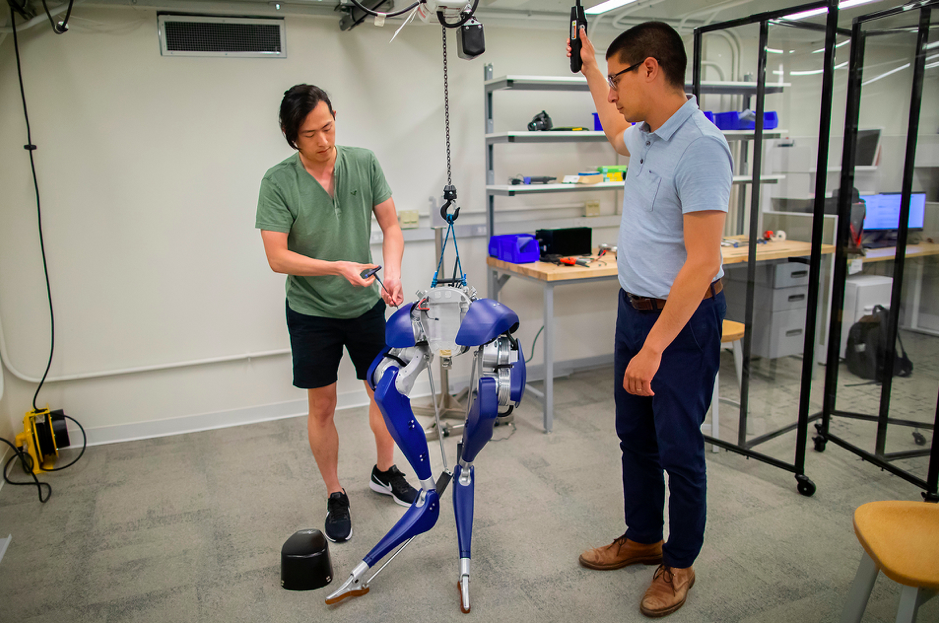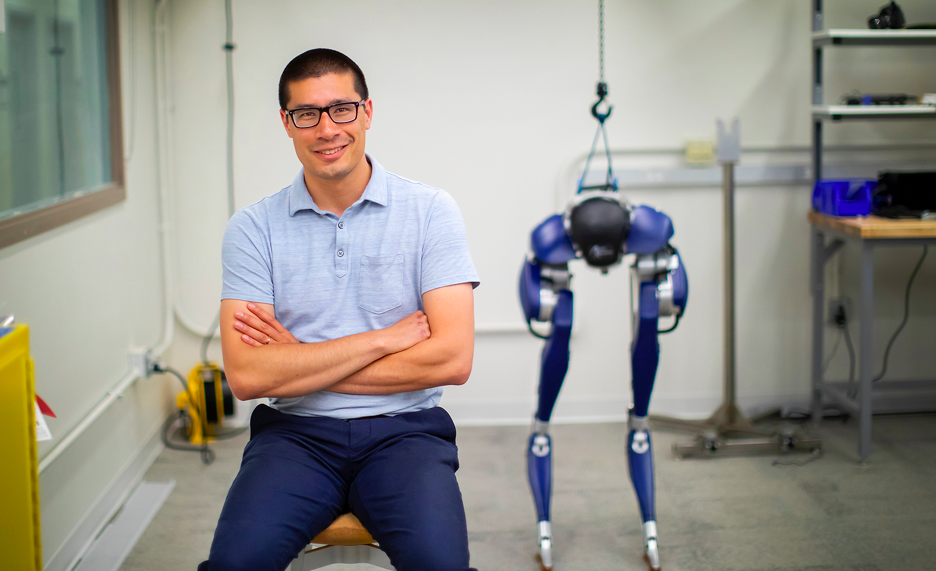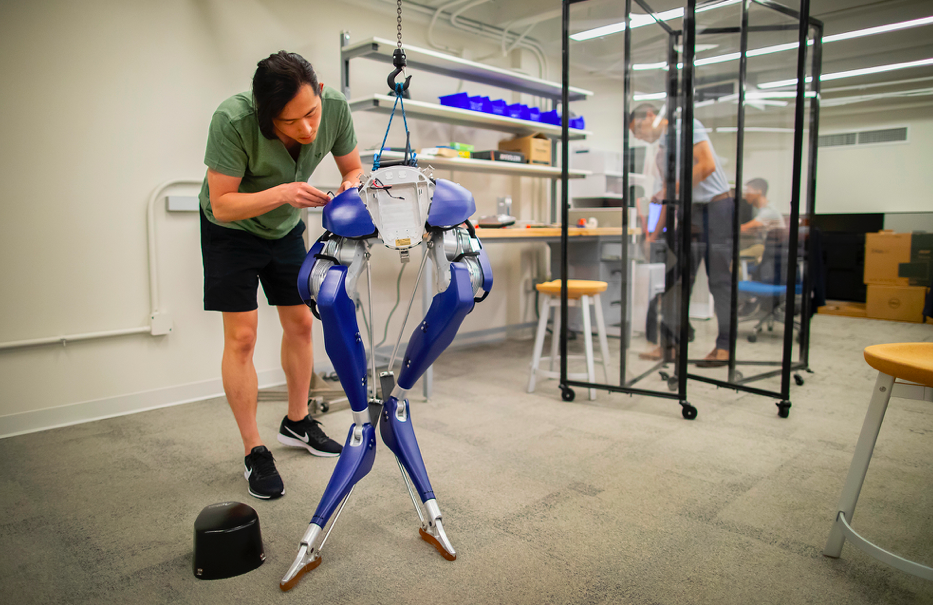
Working in the Dynamic Autonomy and Intelligent Robotics lab at the University of Pennsylvania, Michael Posa (right) and graduate student Yu-Ming Chen use Cassie to help develop better algorithms that can help robots move more like people. | Credit: Eric Sucar
What has two legs, no torso, and hangs out in the basement of the University of Pennsylvania’s Towne Building?
It’s Cassie, a dynamic bipedal robot, a recent addition to Michael Posa’s Dynamic Autonomy and Intelligent Robotics (DAIR) Lab. Built by Agility Robotics, a company in Albany, Oregon, Cassie offers Posa and his students the chance to create and test the locomotion algorithms they’re developing on a piece of equipment that’s just as cutting-edge as their ideas.
“We’re really excited to have it. It offers us capabilities that are really unlike anything else on the commercial market,” says Posa, a mechanical engineer in the School of Engineering and Applied Science. “There aren’t many options that exist, and this means that every single lab that wants to do walking research doesn’t have to spend three years building its own robot.”
Having Cassie lets Posa’s lab members spend all their time working to solve the huge challenge of designing algorithms so that robots can walk and navigate across all kinds of terrain and circumstances.
“What we have is a system really designed for dynamic locomotion,” he says. “We get very natural speed in terms of leg motions, like picking up a foot and putting it down somewhere else. For us, it’s a really great system.”

“It offers us capabilities that are really unlike anything else on the commercial market,” Posa says about Cassie. | Credit: Eric Sucar
Why do the legs matter? Because they dramatically expand the possibilities of what a robot can do. “You can imagine how legged robots have a key advantage over wheeled robots in that they are able to go into unstructured environments. They can go over relatively rough terrain, into houses, up a flight of stairs. That’s where a legged robot excels,” Posa says. “This is useful in all kinds of applications, including basic exploration, but also things like disaster recovery and inspection tasks. That’s what’s drawing a lot of industry attention these days.”
Of course, walking over different terrain or up a curb, step, or other incline dramatically increases what a robot has to do to stay upright. Consider what happens when you walk: Bump into something with your elbow, and your body has to reverse itself to avoid knocking it over, as well as stabilize itself to avoid falling in the opposite direction.
Related: Ford package delivery tests combine autonomous vehicles, bipedal robots
A robot has to be told to do all of that – which is where Posa’s algorithms come in, starting from where Cassie’s feet go down as it takes each step.
“Even with just legs, you have to make all these decisions about where you’re going to put your feet,” he says. “It’s one of those decisions that’s really very difficult to handle because everything depends on where and when you’re going to put your feet down and putting that foot down crates an impact: You shift your weight, which changes your balance, and so on.
“This is a discrete event that happens quickly. From a computational standpoint, that’s one of the things we really struggle with—how do we handle these contact events?”
Then there’s the issue of how to model what you want to tell the robot to do. Simple modeling considers the robot as a point moving in space rather than, for example, a machine with six joints in its leg. But of course, the robot isn’t a point, and working with those models means sacrificing capability. Posa’s lab is trying to build more sophisticated models that, in turn, make the robot move more smoothly.
“We’re interested in the sort of middle ground, this Goldilocks regime between ‘this robot has 12 different motors’ and ‘this robot is a point in space,'” he says.
Related: 2019 the Year of Legged Robots
Cassie’s predecessor was called ATRIAS, an acronym for “assume the robot is a sphere.” ATRIAS allowed for more sophisticated models and more ability to command the robot, but was still too simple, Posa says. “The real robot is always different than a point or sphere. The question is where should our models live on this spectrum, from very simple to very complicated?”
Two graduate students in the DAIR Lab have been working on the algorithms, testing them in simulation and then, finally, on Cassie. Most of the work is virtual, since Cassie is really for testing the pieces that pass the simulation test.
“You write the code there,” says Posa, gesturing at a computer across the lab, “and then you flip a switch and you’re running it with the real robot. In general, if it doesn’t work in the simulator, it’s not going to work in the real world.”

Graduate students, including Chen (left), work on designing new algorithms and running computer simulations before testing them on Cassie. | Credit: Eric Sucar
On the computer, the researchers can take more risks, says graduate student Yu-Ming Chen. “We don’t break the robot in simulation,” he says, chuckling.
So what happens when you take these legs for a spin? The basic operation involves a marching type of step, as Cassie’s metal feet clang against the floor. But even as the robot makes these simple motions, it’s easy to see how the joints and parts work together to make a realistic-looking facsimile of a legged body from the waist down.
With Cassie as a platform, Posa says he’s excited to see how his team can push locomotion research forward.
“We want to design algorithms to enable robots to interact with the world in a safe and productive fashion,” he says. “We want [the robot] to walk in a way that is efficient, energetically, so it can travel long distances, and walk in a way that’s safe for both the robot and the environment.”
Editor’s Note: This article was republished from the University of Pennsylvania.
阅读原文